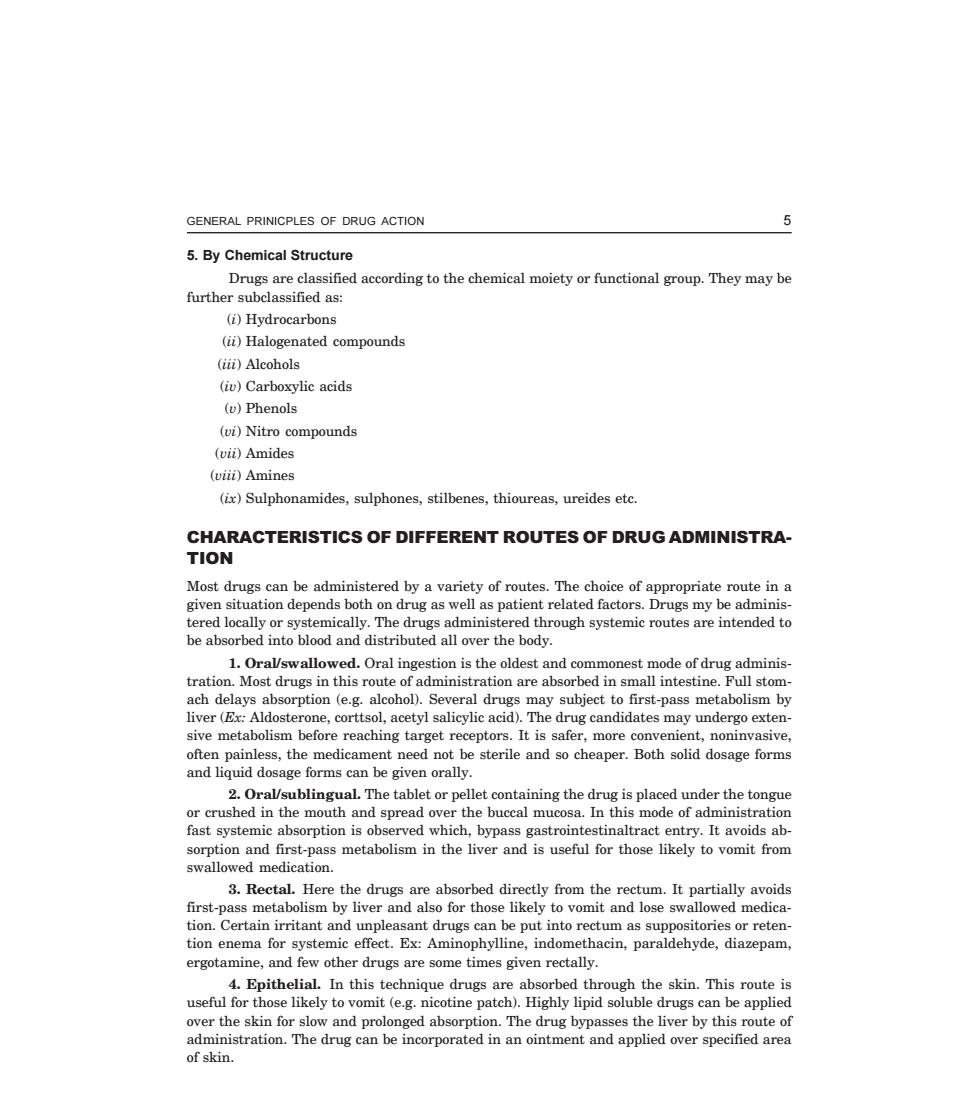正在加载图片...

GENERAL PRINICPLES OF DRUG ACTION 5 5.By Chemical Structure Drugs are classified according to the chemical moiety or functional group.They may be further subclassified as (i)Hydrocarbons (ii)Halogenated compounds (iii)Alcohols (iv)Carboxylic acids (v)Phenols (i)Nitro compounds (vii)Amides (viii)Amines (ix)Sulphonamides,sulphones,stilbenes,thioureas,ureides etc CHARACTERISTICS OF DIFFERENT ROUTES OF DRUG ADMINISTRA- TION Most drugs can be administered by a variety of routes.The choice of appropriate route in a given situation depends both on drug as well as patient related factors.Drugs my be adminis- tered locally or systemically.The drugs administered through systemic routes are intended to be absorbed into blood and distributed all over the body. 1.Oralswallowed.oral ingestion is the oldest and commonest mode of drug tration.Most dr ugs in this route of administration are absorbed in small intestine.Full stom ach delays abs tion (e.g.alcohol).Several drugs may subject to first-pass metabolism by liver(Ex:Aldosterone,corttsol,acetyl salicylic acid).The drug candidates may undergo exten- sive metabolism before reaching target receptors.It is safer.more convenient.noninvasive. often painless,the medicament need not be sterile and so cheaper.Both solid dosage forms and liquid dosage forms can be given orally. 2.Oral/sublingual.The tablet or pellet containing the drug is placed under the t or crushed in the mouth and spread over the buccalm mode of administratio fast systemic absorption is observed which.bypass gastrointestinaltract entry.It avoids ab. sorption and first-pass metabolism in the liver and is useful for those likely to vomit from swallowed medication. nd also m.It p 4ia11 first- ed tiommtAmiindmtadreten ergotamine,and few other drugs are some times given rectally. s rout tine skin fo nged absorpt Th drug bypa h。 verby thi be app e an oint nd of skin. drug can over specified areGENERAL PRINICPLES OF DRUG ACTION 5 C-8—N-CHEMI\CHE2-1.PM5 5. By Chemical Structure Drugs are classified according to the chemical moiety or functional group. They may be further subclassified as: (i) Hydrocarbons (ii) Halogenated compounds (iii) Alcohols (iv) Carboxylic acids (v) Phenols (vi) Nitro compounds (vii) Amides (viii) Amines (ix) Sulphonamides, sulphones, stilbenes, thioureas, ureides etc.
Most drugs can be administered by a variety of routes. The choice of appropriate route in a given situation depends both on drug as well as patient related factors. Drugs my be administered locally or systemically. The drugs administered through systemic routes are intended to be absorbed into blood and distributed all over the body. 1. Oral/swallowed. Oral ingestion is the oldest and commonest mode of drug administration. Most drugs in this route of administration are absorbed in small intestine. Full stomach delays absorption (e.g. alcohol). Several drugs may subject to first-pass metabolism by liver (Ex: Aldosterone, corttsol, acetyl salicylic acid). The drug candidates may undergo extensive metabolism before reaching target receptors. It is safer, more convenient, noninvasive, often painless, the medicament need not be sterile and so cheaper. Both solid dosage forms and liquid dosage forms can be given orally. 2. Oral/sublingual. The tablet or pellet containing the drug is placed under the tongue or crushed in the mouth and spread over the buccal mucosa. In this mode of administration fast systemic absorption is observed which, bypass gastrointestinaltract entry. It avoids absorption and first-pass metabolism in the liver and is useful for those likely to vomit from swallowed medication. 3. Rectal. Here the drugs are absorbed directly from the rectum. It partially avoids first-pass metabolism by liver and also for those likely to vomit and lose swallowed medication. Certain irritant and unpleasant drugs can be put into rectum as suppositories or retention enema for systemic effect. Ex: Aminophylline, indomethacin, paraldehyde, diazepam, ergotamine, and few other drugs are some times given rectally. 4. Epithelial. In this technique drugs are absorbed through the skin. This route is useful for those likely to vomit (e.g. nicotine patch). Highly lipid soluble drugs can be applied over the skin for slow and prolonged absorption. The drug bypasses the liver by this route of administration. The drug can be incorporated in an ointment and applied over specified area of skin.��������